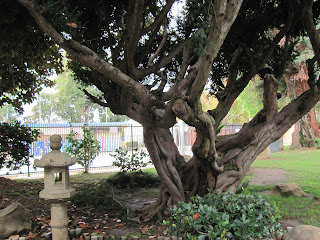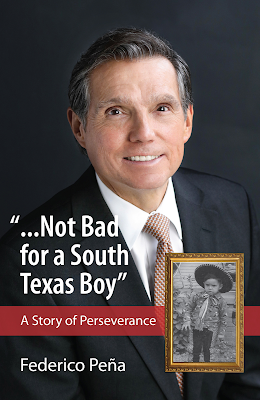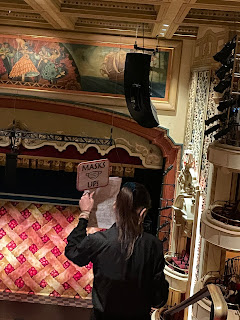Daniel Cano
Note: Some fight to keep our stories out of our schools. We must fight to keep them in. Dedicated to the teachers fighting the "good" fight.
 |
| Bart and Pearl Carrillo, smiling towards the future |
Bart Carrillo’s father, Santos
Carrillo, was born in 1899 in Moyahua, Zacatecas and came to the U.S. in 1915.
"My dad went back to Mexico,"
Bart said, "to fight for Pancho Villa."
In Mexico, Santos met Inez Medina, also of Moyahua, and soon after, they
married and started a family. The fighting between rebel and federal forces
intensified, so Santos and Inez--along with thousands of other
Mexicans--decided to leave Mexico and move permanently to the U.S., joining a
great wave of Mexican immigrants north.
Santos worked in Arizona taking whatever job he could find. "My dad
dug holes, worked the mines, and picked vegetables and fruit,” Bart said.
"When my dad got to Sawtelle (today’s West Los Angeles), he heard they
needed workers out by the Veterans Cemetery.”
He chuckled as he told me how his dad, Santos, who spoke no English,
showed up early one morning at the job site looking for work. The supervisor,
probably wanting to get rid of him, asked if he could pour concrete and lay a
cement sidewalk.
"My dad didn't know the first thing about cement work. He never
learned, but he needed a job."
“Yes,” Santos answered. The supervisor handed him a trowel, and said, "Show me." The Anglo workers stopped to watch. Santos stooped
down into the cement, turning the trowel different ways, figuring how it
worked. He started slapping awkwardly at the wet cement. Everybody went wild
with laughter. Santos got up to leave, but the supervisor called him back and hired
him on the spot. Bart said, “I guess the boss figured if my dad had the guts to
humiliate himself like that, he could make a good worker.”
Santos didn't know it at the time, but he was helping lay the first
sidewalks for what was to become the Westwood Village. Still, Santos’ dream was
to one day be his own boss.
Pearl Pino Carrillo, a bright smile on her face, said her father,
Alejandro Pino, was born on Oct 9, 1900, in Peticato, Sonora, in northern
Mexico. When he was nineteen years old, Alejandro left Mexico and moved to Arizona searching for work. There he met
Carmela Arujo, the girl he’d one day marry. However, looking for better job
opportunities, Alejandro moved from Arizona to L.A.’s westside, a little town
known as Sawtelle.
Pearl said that her maternal grandfather, Feliciano, worked quite a few
years in Arizona for a man named A. J. Stoner. When Stoner left Arizona to open
Sawtelle Lumber at the corner of Santa Monica Boulevard and Cotner Avenue, he
invited Feliciano to move his family out west and work in the lumberyard.
Feliciano agreed. The family settled in, Carmela and Alejandro found each other,
and rekindled their relationship, eventually marrying at St. Sebastian Church
in 1922, and six years later, 1928, Pearl was born in the Sawtelle family home.
J. Stoner went on to become an important developer in Sawtelle, and the
town would name a park and street in his honor, ironically, the same street
where Bart and Pearl would purchase their last home.
 |
| Stoner Park, the Japanese Garden |
WWII was heating up. Bart and Pearl were dating. Just before he joined
the Navy, Bart asked his dad if he would go ask Mr. Pino for Pearl’s hand in
marriage. "That's how it was done in those days, an arrangement between
the fathers."
After visiting, what seemed like all day, with Pearl’s father, Bart’s
dad, Santos, returned home. Bart was wild with anticipation, but his father
didn't say anything. Finally, Bart, unable to control himself, asked
his dad, "What happened?"
Santos
told Bart that Mr. Pino needed two weeks to think about it. Bart didn't
understand. What was there to think
about? Bart and Pearl had already been dating.
The two families had known each other for years. Still, Bart knew better than
to question adults. The two weeks seemed like months. After the second week passed, and his dad still said nothing, Bart reluctantly approached him again.
"Oh, yeah," his dad said, casually, "Mr. Pino said
fine."
The long delay confused Bart. It wasn’t until years later his father
told him, laughing, that Pearl's dad had given his blessing the same day Santos
Carrillo had asked. The two men figured they'd make the kids sweat it out a
little.
After a stint in the navy on a destroyer, the Dale, Bart returned home.
He and Pearl began working at boring jobs, Bart gardening, a trade he’d learned
before the Navy. Like his father, Bart couldn't see himself working for anybody
else. So, he and his father went into business with a relative who lived in Tijuana. After the war,
Tijuana boomed, catering to American tourists and servicemen from San Diego.
The Carrillos opened a curio shop,
selling souvenirs to tourists.
Bart loved it, the bargaining, the socializing, and the feeling of being
self-employed. As a Chicano who spoke English and Spanish, Bart liked haggling
over prices with his fellow Yankees, who always believed they were getting the
best price. Bart laughed, “My dad would give me the rock bottom price of an
item, and I'd take it from there. We always made money, no matter how little we
sold it for.”
The Carrillos opened two more stores. Bart, his father, and relative
were putting in a lot of hours each day, working hard to bring in the inventory
and sell it as quickly as possible.
Bart said, “But oh man, the drive from West L.A. to Tijuana was getting
to be too much.”
This was before the 405 Freeway cut through Orange County, and the drive
to Tijuana along the Coast Highway could take up to five hours. “I didn’t like
leaving Pearl
at home alone all that time. It was a really hard time.”
Bart said American tourists flooded the border town. The competition
with other curio shops in TJ increased. Bart realized he couldn’t keep the
business up for too much longer, so he talked his father into selling and
taking the money and investing in a tavern in Santa Monica, an idea he’d had for some time.
His dad agreed.
The Carrillos opened Tijuanita,
a tavern on Main Street
and Pico Boulevard,
in the heart of Santa Monica,
across from the Memorial Auditorium, known for its boxing
cartels. Inez and Pearl
cooked. Santos
and Bart brought in the customers. Pearl
took care of the paperwork. After boxing matches, the Memorial Auditorium
provided a constant flow hungry men and women, sometimes up until midnight and
even to the early morning hours. Chicanos crammed the neighborhood. On
weekends, everyone came to Ocean
Park to attend the concerts
and dances at the Aragon Ballroom.
My father once said of Tijuanita,
“Bart’s mom made the best menudo in
town. On weekends the line was so
long people couldn't even get in.”
The young couple decided to move from West L.A. and buy a home in Santa
Monica, the first of twelve Westside homes they’d come to own. It was in an
Anglo area, far from her family in Sawtelle.
Pearl said, “After we bought the house, we couldn’t even afford a
refrigerator, a stove, or any furniture. I felt alone. I didn’t like the area
because I felt like we were so far away from Sawtelle where all of my family
and friends lived. Five miles was like a hundred in those days.”
Bart and his father began
investing in real estate, rental property. “Oh, what a headache,” Bart said. “I
lost a lot if sleep during that time.”
Rather than sell the family home in Sawtelle, Bart and his father
decided to rent it, Bart recalled, “…to a gringo family.” After some months,
the renters stopped sending the rent payments. “The guy just refused,” Bart
said.
Months went by and still no rent money arrived. Santos and Bart decided
they couldn’t go to the police or courts. The law moved slowly. They didn't want
to threaten the man and make the situation worse.
Bart said, “The guy was always complaining about simple repairs, so we
figured he wasn't very handy with tools. One night we sneaked in and
disconnected the water heater. It was winter and cold. I guess, he didn't know
how to reconnect the pipes, and he couldn't call us because he owed us so much
money. After a few weeks of cold water, he moved out, just like that. You
always had to be using your head."
Customers crowded Tijuanita.
Inez Carrillo added new foods to the menu. Always the businessman, Bart knew he
had to move the restaurant to a bigger place. He wanted to stay in Santa Monica. He knew the
importance of a good location. The wrong move could mean disaster.
He found a perfect building on the eastern part of Santa Monica, on Pico
Boulevard, a main street for thousands of people visiting the beaches on
weekends.
The mid-1950s…. The Bundy Theater was just up the street. Every Saturday
and Sunday evening, people leaving the movies and bars filled Pico Boulevard. The
Korean War was stirring. Three shifts of workers from Douglas Aircraft Co. on
Ocean Park Boulevard, just blocks from Carrillo's Restaurant, guaranteed that
workers packed the restaurant at all hours.
Carrillo’s, along with Casa Escobar, began to attract customers from all
over the Westside, including Brentwood and Beverly Hills. Americans had
discovered tacos and enchiladas. Bart worked over-time catering to the
customers’ needs, but he also anticipated a change in the area.
With all the wars ending, Douglas Aircraft downsized. Gone were
the round-the-clock shifts. The government tore down the Bundy Theater to make
way for the new Santa Monica freeway. Other Mexican restaurants set up shop
along Pico Boulevard and the Westside.
Juan Escobar had firmly established his Casa Escobar in Westwood as the Mexican choice for the more upper
crust clientele--the fur coat, suit-and-tie crowd. Outdoor attendants were
needed to park the luxury cars that pulled up to the restaurant doors.
It didn’t take Bart long to recognize the lull in his business. He knew
he needed to change. Assisted by his brother Carmen, a contractor, Bart
remodeled the restaurant, complete with dance floor, tables, Mexican arches,
and upholstered booths. Business picked up. The Westside population and income
levels soared. Bart's restaurant began to cater to a solid middle-class
clientele.
The skyrocketing property values in Santa Monica and WLA began to
reverberate through the Westside, and since Bart didn’t own the property where his restaurant was located, he knew, to survive, he would have to buy his
own property.
Bart found a perfect lot up the street from his restaurant, but he’d
also heard the owner had already rejected numerous offers to sell. Desperate,
Bart met with the owner, who also owned the Rexall Drug Store nearby. Bart explained his predicament. To Bart's surprise, the man agreed to sell. Bart's
landlord became infuriated because he had already tried to buy the lot.
This gave Bart some leverage. If the owner of the property where
Carrillos was located demanded an unreasonable increase in rent, Bart would
simply pull his business and build again on his own property. Bart and the
landlord negotiated a new ten-year lease at a fair price. As Bart told me, “One
that I could live with.”
He said it worked out because he didn't want to invest the money and time
to build a new restaurant if he didn’t have to. He also began thinking it
didn’t make sense making mortgage payments on the vacant land, so he sold his
lot on Pico for a decent profit to a local realtor.
It wasn’t until later, Bart found out that McDonald’s was interested in
the lot. It was to be one of the first McDonald’s on the Westside. "I had
no idea how much that land was really worth," he said. "Mistakes
happen, and I've made my share." He smiled at Pearl. "That was a big one.”
The ten-year lease on his restaurant passed quickly. In the late 1970s, Westside
real estate skyrocketed. His rent jumped from $700 to $6,000. He had no choice
but to turn off the lights on his beloved restaurant. Though, he said, "I
was getting tired of all the work and staying so late every night."
As Bart and Pearl
told me their life story, they both spoke contentedly, not that everything had
been easy. They had experienced difficult, trying times as well. Still, the
Carrillos considered themselves among a special group of pioneers who
introduced the modern version of Mexican culture, not just food, to the
Westside.
Bart said one of the things of which he was most proud was having hired
many workers, young and old, from both sides of the border, men and women of
various ages and ethnic groups. Of those who came from Mexico, he
encouraged and assisted in helping with citizenship or residency. He helped them buy their first homes and send
their children to school. He talked about many of his ex-employees who today
own businesses. Many of their children have gone to college and entered
respected professions.
After Bart closed his restaurant, he invested in a number of smaller
fast-food restaurants, which he opened in shopping centers and malls throughout
the Westside and Los Angeles.
Again, his businesses flourished, but by the 1990s, he realized that it was all
too much an emotional and financial strain. He sold his restaurants and
settled into a comfortable retirement.
In 1998, they sold their Rancho Park
home, their pride and joy.
"We designed and built that house. We lived there for thirty-five
years, and it's where we raised our children," Pearl said. She showed me photos of a
two-story house, its modernist architecture reminiscent of Frank Geary's work.
Bart said, to keep busy, he spends some hours doing gardening at one of
his son’s businesses. He told me, “Right back where I started.” Pearl laughed.


















